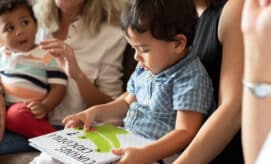One of the most exciting aspects of working with young children is the opportunity to witness and support their unique growth and discovery processes. This is especially true during infancy, when children are growing and changing every day!
When it comes to emerging language skills, caregivers and educators can provide encouragement and support by engaging children in back and forth conversations — often referred to as “serve and return” interactions or “conversational turns.”
Understanding Serve & Return and Conversational Turns
When we think about language development, our minds often go to little ones learning to say their first words, but infants are learning communication skills long before they are able to use speech and verbal language. When infants are babbling, cooing, and gesturing, they are already beginning to communicate and understand the basics of conversational language. When an adult talks to an infant and the infant responds with vocal sounds, these exchanges are often referred to as “serve and return interactions” or “conversational turns.”
Harvard University’s Center on the Developing Child defines “serve and return” as interactions that “shape brain architecture. When an infant or young child babbles, gestures, or cries, and an adult responds appropriately with eye contact, words, or a hug, neural connections are built and strengthened in the child’s brain that support the development of communication and social skills. Much like a lively game of tennis, volleyball, or Ping-Pong, this back-and-forth is both fun and capacity-building.” To learn more, you might enjoy this video from The Center on the Developing Child:
LENA, a research-based, nonprofit organization whose mission is to help accelerate language development in children from birth to three, refers to these same exchanges as “conversational turns.” LENA’s article, Understanding Conversational Turns, explains that the back-and-forth exchange describes a variety of different ways for young children to communicate, adding that: “any speech-like, non-cry sound counts as a turn — from an infant’s coos to a toddler’s words (either real or made up).”
Talking With — Rather Than Talking To Children
There are some common misconceptions about the way that conversations with children help to develop language skills. What is important to remember is that it is not merely about talking to children, but about creating opportunities for conversations with them. The back-and-forth exchanges of words and sounds gives children a chance to practice important language skills. When we talk with children, we involve them in the conversation, engaging them in the learning process and setting into motion important neural connections.
Meredith Rowe, EdD, professor at the Harvard Graduate School of Education, adds that “our work shows that the quality of the talk matters more than the quantity, and that children themselves need to be engaged in the conversations for more learning to occur… It’s the conversations that are key to learning. Perhaps even more importantly, this isn’t all about learning words – it’s about building knowledge, as words bring with them concepts and ideas.”
Putting it Into Practice
The Center on the Developing Child at Harvard University explains: “When caregivers are sensitive and responsive to a young child’s signals and needs, they provide an environment rich in serve and return experiences.”
As you care for little ones, think about talking with them throughout the day. Talk about what you’re going to have for lunch or what kinds of activities you have planned for the day, and ask them questions to engage them in the conversation. The best part about these conversations is that they can happen at any time. These exchanges are especially critical for infants, whose language skills are still emerging. Respond to their coos, gestures, babbles and sounds to encourage their communication. These back and forth exchanges are great opportunities for brain building — and they are also special opportunities to bond with the children in your care!
Additional Printable Resources







